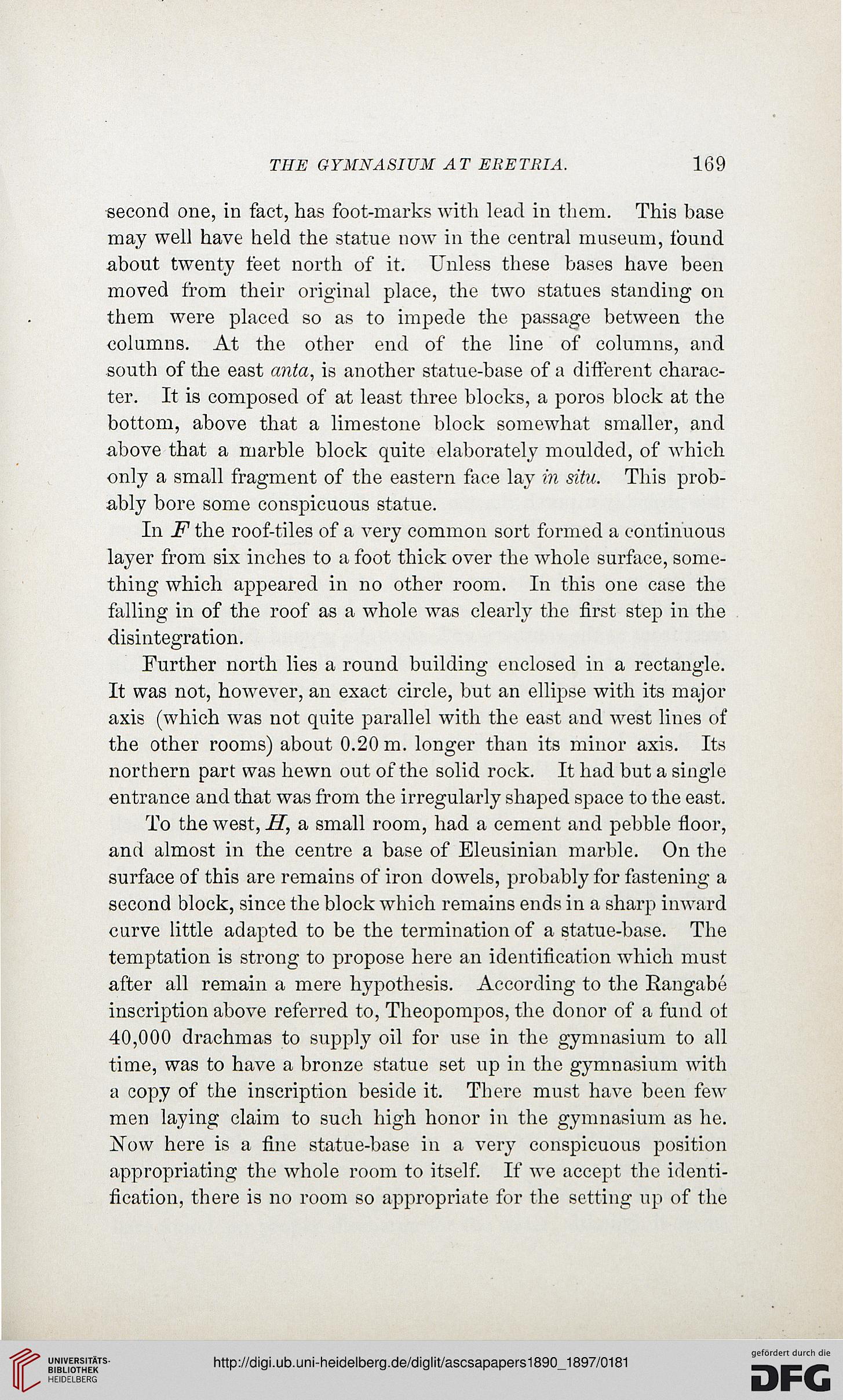THE GYMNASIUM AT ERETRIA.
169
second one, in fact, has foot-marks with lead in them. This base
may well have held the statue now in the central museum, found
about twenty feet north of it. Unless these bases have been
moved from their original place, the two statues standing on
them were placed so as to impede the passage between the
columns. At the other end of the line of columns, and
south of the east anta, is another statue-base of a different charac-
ter. It is composed of at least three blocks, a poros block at the
bottom, above that a limestone block somewhat smaller, and
above that a marble block quite elaborately moulded, of which
only a small fragment of the eastern face lay in situ. This prob-
ably bore some conspicuous statue.
In F the roof-tiles of a very common sort formed a continuous
layer from six inches to a foot thick over the whole surface, some-
thing which appeared in no other room. In this one case the
falling in of the roof as a whole Avas clearly the first step in the
disintegration.
Further north lies a round building enclosed in a rectangle.
It was not, however, an exact circle, but an ellipse with its major
axis (which was not quite parallel with the east and west lines of
the other rooms) about 0.20 m. longer than its minor axis. Its
northern part was hewn out of the solid rock. It had but a single
entrance and that was from the irregularly shaped space to the east.
To the west, H, a small room, had a cement and pebble floor,
and almost in the centre a base of Eleusinian marble. On the
surface of this are remains of iron dowels, probably for fastening a
second block, since the block which remains ends in a sharp inward
curve little adapted to be the termination of a statue-base. The
temptation is strong to propose here an identification which must
after all remain a mere hypothesis. According to the Rangabe
inscription above referred to, Theopompos, the donor of a fund ot
40,000 drachmas to supply oil for use in the gymnasium to all
time, was to have a bronze statue set up in the gymnasium with
a copy of the inscription beside it. There must have been few
men laying claim to such high honor in the gymnasium as he.
IsTow here is a fine statue-base in a very conspicuous position
appropriating the whole room to itself. If we accept the identi-
fication, there is no room so appropriate for the setting up of the
169
second one, in fact, has foot-marks with lead in them. This base
may well have held the statue now in the central museum, found
about twenty feet north of it. Unless these bases have been
moved from their original place, the two statues standing on
them were placed so as to impede the passage between the
columns. At the other end of the line of columns, and
south of the east anta, is another statue-base of a different charac-
ter. It is composed of at least three blocks, a poros block at the
bottom, above that a limestone block somewhat smaller, and
above that a marble block quite elaborately moulded, of which
only a small fragment of the eastern face lay in situ. This prob-
ably bore some conspicuous statue.
In F the roof-tiles of a very common sort formed a continuous
layer from six inches to a foot thick over the whole surface, some-
thing which appeared in no other room. In this one case the
falling in of the roof as a whole Avas clearly the first step in the
disintegration.
Further north lies a round building enclosed in a rectangle.
It was not, however, an exact circle, but an ellipse with its major
axis (which was not quite parallel with the east and west lines of
the other rooms) about 0.20 m. longer than its minor axis. Its
northern part was hewn out of the solid rock. It had but a single
entrance and that was from the irregularly shaped space to the east.
To the west, H, a small room, had a cement and pebble floor,
and almost in the centre a base of Eleusinian marble. On the
surface of this are remains of iron dowels, probably for fastening a
second block, since the block which remains ends in a sharp inward
curve little adapted to be the termination of a statue-base. The
temptation is strong to propose here an identification which must
after all remain a mere hypothesis. According to the Rangabe
inscription above referred to, Theopompos, the donor of a fund ot
40,000 drachmas to supply oil for use in the gymnasium to all
time, was to have a bronze statue set up in the gymnasium with
a copy of the inscription beside it. There must have been few
men laying claim to such high honor in the gymnasium as he.
IsTow here is a fine statue-base in a very conspicuous position
appropriating the whole room to itself. If we accept the identi-
fication, there is no room so appropriate for the setting up of the




